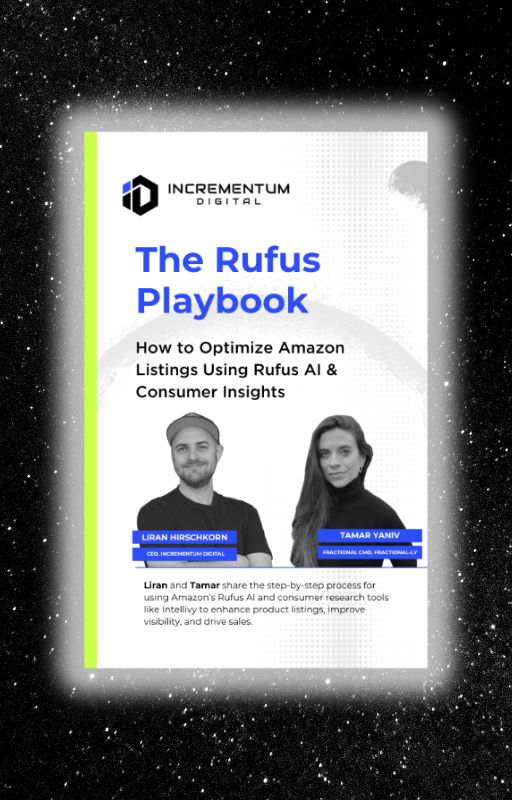Amazon Advertising
3 Hidden Leaks in Most Amazon Ad Accounts (and How to Fix Them)

Scaling on Amazon isn’t just about turning up your ad spend, it’s about smart, precise optimizations that drive real, profitable growth. Whether you’re preparing for a major sales event or tightening up your evergreen strategy, understanding where your budget might be leaking is critical. In this quick video, Haider Ali, one of our Advertising Team Leads, shares his top three insights on identifying and fixing costly ad spend leaks. With millions in ad spend experience across dozens of Amazon brands, he knows exactly where budgets tend to bleed and how to stop it.

Learn How to Make Listings That Convert in 2025!
Read our step-by-step guide on how to optimize your listings using Rufus AI insights. Sign up for our newsletter and get your copy for free!
Show me howHere’s a closer look at three common ad spend leaks Haider has identified, along with practical ways to fix them:
Leak #1: Overspending on the Wrong Days or Hours
Not all hours or days are created equal when it comes to buyer intent. However, many brands default to running their ads throughout the day, assuming that constant exposure means better visibility and sales. As such, this approach can be a major drain on your budget.
Worse yet, if your ads are active on days when your target audience isn’t shopping, you’re essentially paying for impressions that won’t convert. For sellers prepping for Prime Day or other major sales events, this mistake can be even more costly, as budgets are typically higher and competition is fierce.
Haider says: Running ads 24/7 might seem like the default, but it can cost you. If your campaigns are active during low-converting hours, like late at night or very early hours, or on days when your shoppers aren’t buying, you’re essentially paying for traffic that doesn’t convert.
Quick Fix:
-
- Analyze performance data from the past 8 weeks to identify your sales trends and know your top-performing time windows.
- Use ad management software that supports dayparting to shift budget toward high-performing hours and days automatically.
- Even small adjustments here can deliver big returns in efficiency.
Why This Works: By shifting your ad spend to match your highest-converting time windows, you maximize your return on investment without increasing your overall budget. This approach eliminates waste by focusing your spend where it drives the most impact, allowing you to scale profitably while maintaining a healthier ACOS. It also reduces the risk of paying for traffic that isn’t likely to convert, which can be a major drag on profitability over time.
Leak #2: Not Reallocating Budget across Campaigns, Match Types, Ad Types, Ad Placements & Products
Effective budget allocation is a core principle of a successful Amazon advertising campaign strategy. But too often, budgets get trapped in underperforming campaigns, match types, or ad placements that don’t deliver the best return on investment (ROI). For example, focusing too heavily on broad match keywords or low-margin ASINs can cannibalize your budget, leaving less room for the high-converting, low-TACOS (Total Advertising Cost of Sales) products that actually drive profit.
Haider points out: Amazon ad budgets often get stuck in the wrong places, whether it’s a poor-performing match type, an underperforming placement, or even across different products. Overspending on inefficient areas is the most common mistake.
Quick Fix:
-
- Set a recurring schedule to review campaign performance.
- Reallocate spend from low-performing areas to those showing stronger results.
- Pay special attention to placements, match types, and ad types.
- Shift ad spend from “high TACOS parent ASINs” to “Low TACOS parent ASINs”
Why This Works: Regularly reviewing your campaigns helps you stay proactive about where your budget is going. By reallocating spend from underperforming areas to those that deliver better returns, you prevent wasted ad dollars and maximize profitability. This approach also helps reduce your overall TACOS by focusing your budget on products and placements that drive profitable growth. It’s a straightforward way to boost ROI without increasing your overall ad spend.
For a deeper dive into bid adjustments and how to make your campaigns more profitable, check out our guide on Amazon Business B2B Customers and New Sponsored Products Updates.
Leak #3: Using the Wrong Lookback Window
Understanding the impact of your Amazon advertising efforts requires a clear, accurate view of your performance data. The lookback window you choose can dramatically influence the insights you gain, directly affecting the decisions you make about bids, budgets, and campaign optimization. Get it wrong, and you risk either overreacting to short-term fluctuations or missing critical long-term trends.
For high-velocity campaigns (like those leading up to Prime Day or seasonal promotions), a shorter lookback window can help you stay agile, catching rapid shifts in shopper behavior and responding quickly to changes in demand. However, for slower-moving or niche products, a longer window can reveal more meaningful patterns that might get lost in the noise of short-term data.
The key is aligning your lookback strategy with your overall Amazon advertising campaign goals. Are you trying to optimize for immediate ROAS or build a long-term brand presence? The right window depends on the lifecycle of the product, its average sales velocity, and the broader competitive landscape.
From Haider: Performance data tells a story, but only if you’re looking at it with the right lens. Too short a lookback window can miss meaningful trends. Too long, and you may overlook recent changes.
Quick Fix:
-
- For high-volume campaigns & targetings, a 7- or 14-day lookback window helps you stay nimble.
- For slow-moving campaigns & targetings, use 30, 60, or even YTD views to see the full picture.
- Always adjust the window to the campaign’s activity level, seasonality, and objective.
Why This Works: Choosing the right lookback window is critical because it directly influences how you interpret performance trends and make optimization decisions. High-volume, fast-moving campaigns require shorter windows to stay responsive to rapid shifts in customer behavior, while slower, long-tail products benefit from longer windows that capture broader performance trends. Aligning your lookback strategy with each campaign’s lifecycle and objectives ensures you’re acting on the most relevant data, avoiding both overreactions to short-term spikes and missed opportunities from longer-term trends.
Bonus Tip: Check Your CPC vs. Bids in the Targeting Tab
One of the quickest ways to improve your Amazon advertising efficiency is to ensure that your bids align with the actual cost-per-click (CPC) you’re paying. This might sound straightforward, but it’s a critical piece of the puzzle that often gets overlooked.
Why It Matters:
-
- If your bids are consistently higher than your actual CPCs, you’re essentially overpaying for traffic, which can drastically reduce your return on ad spend (ROAS) and overall efficiency.
- Tightening this gap can free up budget for better-performing keywords or products, allowing you to scale more effectively and profitably.
- Regularly auditing this gap can help you identify under-optimized keywords that still have potential to drive profitable traffic.
Haider’s advice: Inside Amazon’s campaign manager, head to the Targeting tab. Look for any keywords where your bids are significantly higher than your actual CPCs, especially in high-spend, high-ACOS campaigns. If this is happening, it means you’re still overpaying and have not taken action to optimize. Lowering bids slightly can improve efficiency without hurting performance.
Want a Second Set of Eyes on Your Account?
If it’s been a while since you last reviewed your Amazon campaigns, or just want a second opinion, we’d be happy to take a look. No pitch, just thoughtful, actionable feedback from our Amazon ads team. Reach out here for a complimentary audit.
LET’S DISCOVER WHAT’S POSSIBLE FOR YOUR BRAND
We’re here to listen and uncover opportunities tailored to your unique goals.
Fill out the form to get started, and you’ll walk away with real insights and actionable recommendations—whether we work together or not.
- HANDS-ON LEADERSHIP
- AWARD-WINNING PARTNERSHIPS
- CUSTOM-BUILT SOLUTIONS




